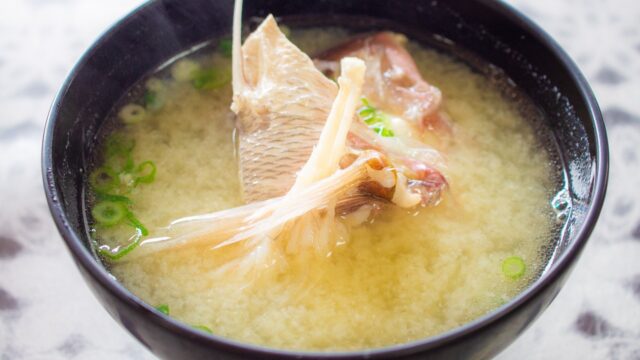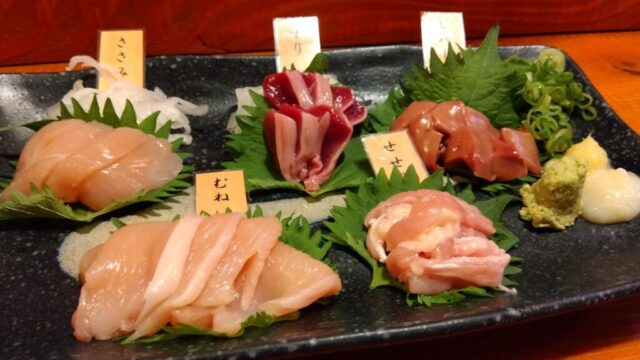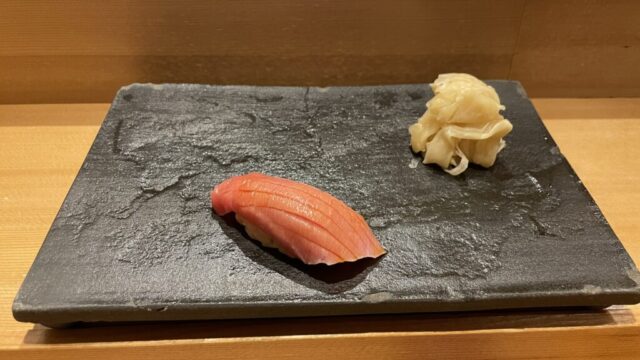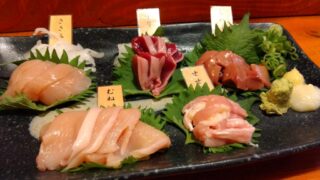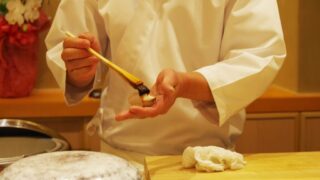When it comes to Sushi, it’s undoubtedly one of the most iconic Japanese foods known worldwide. If you’re someone who enjoys raw fish, I highly recommend trying it when you have the chance to visit Japan. While I’ve had Sushi abroad several times, Japanese Sushi is an entirely different experience, and I encourage all of you to consider it positively when traveling to Japan.
In this article, I’ll provide you with essential information to enhance your Sushi experience.
Types of Sushi Restaurants
In Japan, there are numerous Sushi restaurants, each with its unique style. In this article, I’ll categorize Sushi restaurants into three types and explain their characteristics.
“Kaiten-zushi” – Conveyor Belt Sushi
Conveyor belt Sushi, also known as “kaiten-zushi,” is a popular and casual type of Sushi restaurant that has become widespread in Japan. Sushi plates rotate on a conveyor belt, making it easy for customers to pick their favorites. Some conveyor belt Sushi restaurants also allow customers to place orders using touchscreens, and the Sushi is delivered to their seats. Besides seafood, you can often find a variety of dishes like meat, fried foods, Tempura, and even Ramen. The kitchen is usually located in the back, so you might not witness the Sushi chefs preparing the dishes in front of you. You can have a satisfying meal at these restaurants for around 3,000 to 4,000 yen per person.
Traditional Sushi Restaurants
The most common type of Sushi restaurant in Japan features a counter with several Sushi chefs working behind it. Fresh ingredients are prominently displayed in front of the customers. You can either order individual pieces of Sushi, opt for an Omakase (chef’s recommendation), or select a predetermined course menu. Sushi restaurants in this category vary widely in price, ranging from around 3,000 yen per person to over 10,000 yen. If you’re unsure what to order, you can simply show the staff this message: 「こちらのお客さんに一人当たり予算XXXX円でおまかせコースをお願いします」 which means “Please arrange Omakase course for this customer(s) within a budget of XXXX yen/person.” This message will help you convey your budget by editing XXXX, and leave the choice to the chef.
Please see below linked article for my recommendation.

High-End Sushi Restaurants
If you’re traveling to Japan, I recommend visiting a high-end Sushi restaurant for an even more exquisite culinary experience. These upscale Sushi establishments typically cost over 10,000 yen per person. I suggest checking the restaurant’s budget in advance on platforms like Tabelog. What sets these high-end sushi restaurants apart is that they offer Omakase courses exclusively. However, if you have allergies or specific dislikes, they are accommodating and will substitute ingredients accordingly. Dining at this level allows you to enjoy not only traditional favorites like tuna but also seasonal ingredients prepared in the chef’s recommended style. These restaurants pay attention to every detail, from the knives and utensils to the interior decor and staff attire. Savor your meal and beverages while immersing yourself in a complete sensory experience.
Please see below linked article for my recommendation.
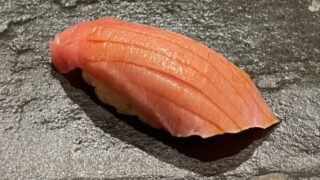
Types of Sushi
When you enter a sushi restaurant, you’ll encounter a variety of Sushi types. Here, I’ll introduce you to the different kinds of Sushi you may come across.
Nigiri
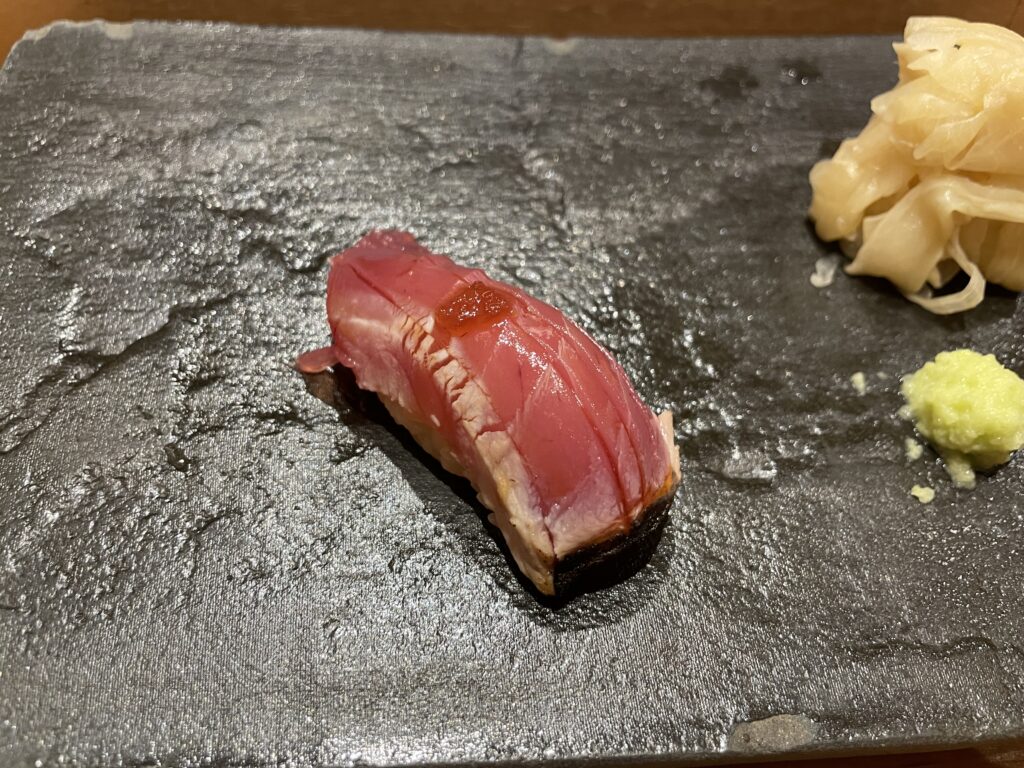
Nigiri is likely what comes to mind when you think of Sushi. It consists of small mounds of vinegared rice -“Shari”- topped with various ingredients, typically seafood. In high-end restaurants, the preparation goes beyond simply placing ingredients on rice; it involves factors like how the Sushi is molded, the pressure applied, and warming the fish with body temperature to enhance flavor. In Japanese households, when we say, “Let’s have Sushi tonight!” it often refers to ordering a platter of Nigiri from a supermarket or delivery service.
Sashimi
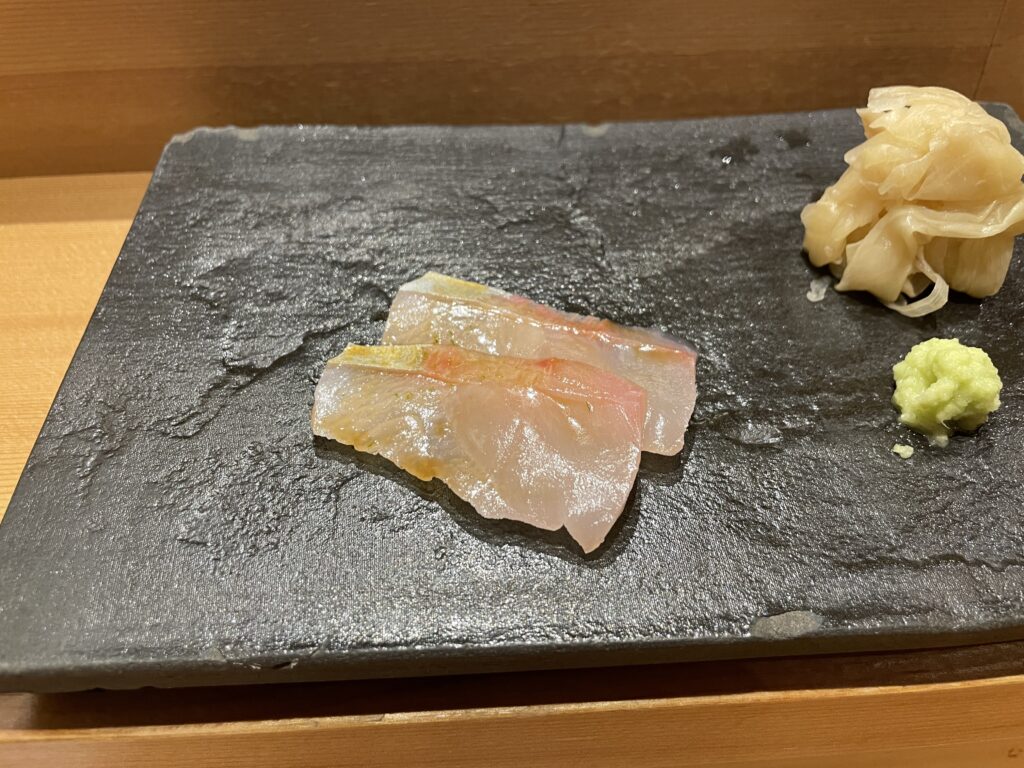
Sashimi is sliced raw seafood and commonly served at Sushi restaurants. Some people prefer Sashimi over Nigiri, especially when they want to enjoy the raw fish without the rice. In regular Sushi restaurants, you can order individual pieces of Sashimi alongside your Sushi. If you’re uncertain about what to order, asking for a Sashimi assortment recommended by the restaurant is a good choice.
Gunkan Maki
Gunkan Maki, or “battleship roll”, is a type of Sushi where a strip of seaweed (Nori) is wrapped around a mound of rice to create a vessel-like shape. It’s often used for ingredients like sea urchin (Uni) or salmon roe (Ikura), which have a loose texture and might otherwise fall off Nigiri-style Sushi.
Hoso-Maki
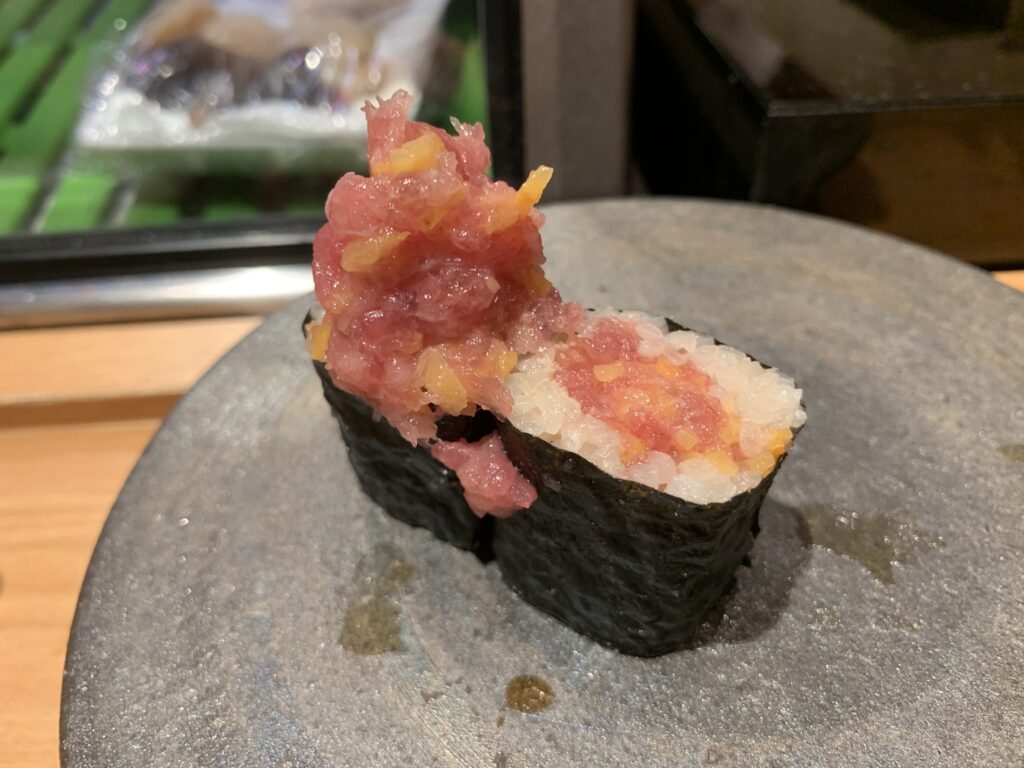
Hoso-Maki means “thin roll” in Japanese, and it refers to rolls where rice and ingredients are wrapped in seaweed (Nori). Unlike Sushi rolls commonly found abroad, which often have rice on the outside and lack seaweed, in Japan, you’ll rarely find such variations. When Japanese cuisine mentions rolls, they are typically wrapped in seaweed.
The ingredients inside Hoso-Maki can vary, ranging from seafood like tuna to non-seafood items like Natto (fermented soybeans) or cucumber.
Futo-Maki
Futo-Maki means “thick roll” and, as the name suggests, these are thick Sushi rolls. Both Hoso-mMaki and Futo-Maki involve using a bamboo mat to roll rice and ingredients in seaweed, but Futo-Maki allows for more ingredients due to its larger size. Unlike Hoso-Maki, which often contains a single main ingredient, Futo-Maki frequently includes multiple ingredients.
“Temaki” – Hand-Rolled Sushi
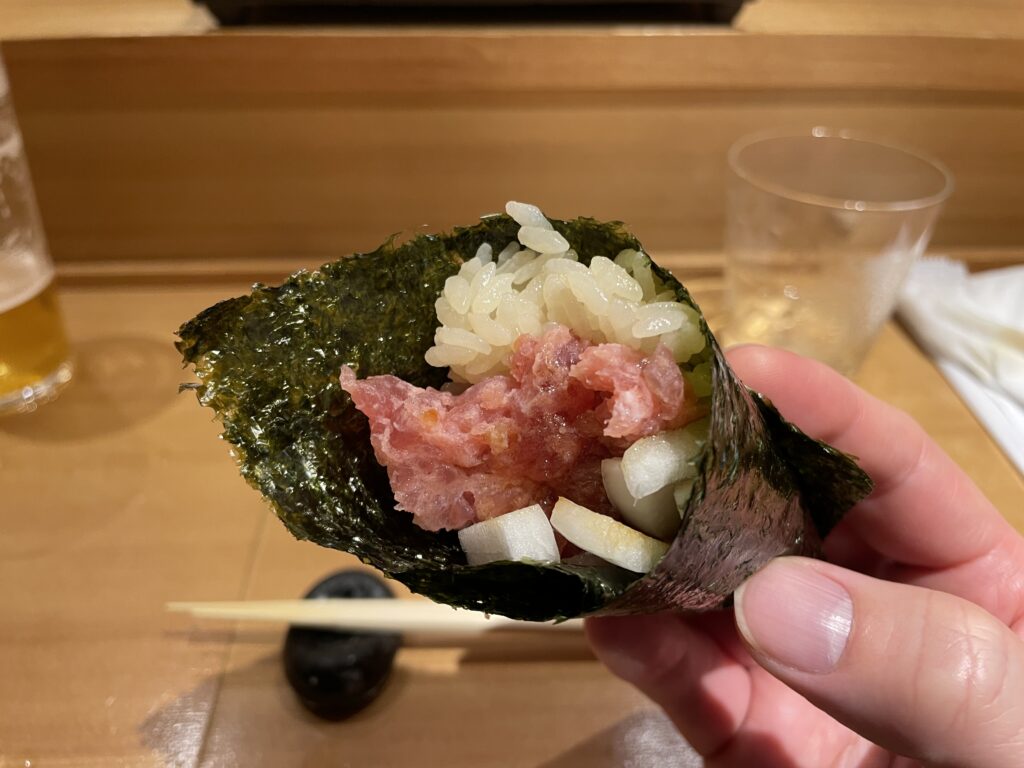 Tuna and Onion Temaki
Tuna and Onion TemakiTe-Maki, or Hand-rolled Sushi, as the name suggests, involves rolling by hand without the use of bamboo mats. It can be rolled into a cylindrical shape or even a cone shape, similar to a scone. Because it can be easily made, it is also commonly found in Japanese home cooking.
Side Dishes
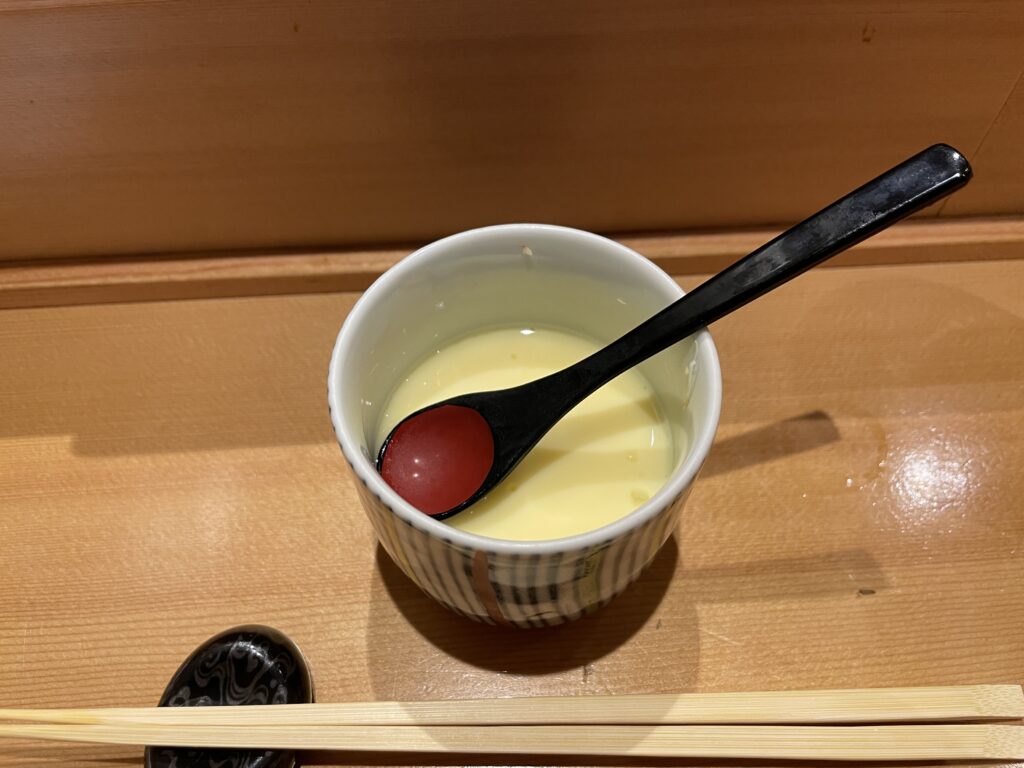 “Chawan-mushi” a savory steamed egg custard
“Chawan-mushi” a savory steamed egg custardIn addition to the items mentioned above, various side dishes are offered by different restaurants. These can include grilled dishes, simmered dishes, fried dishes, and unique preparations specific to certain ingredients or unique creations crafted by the restaurant.
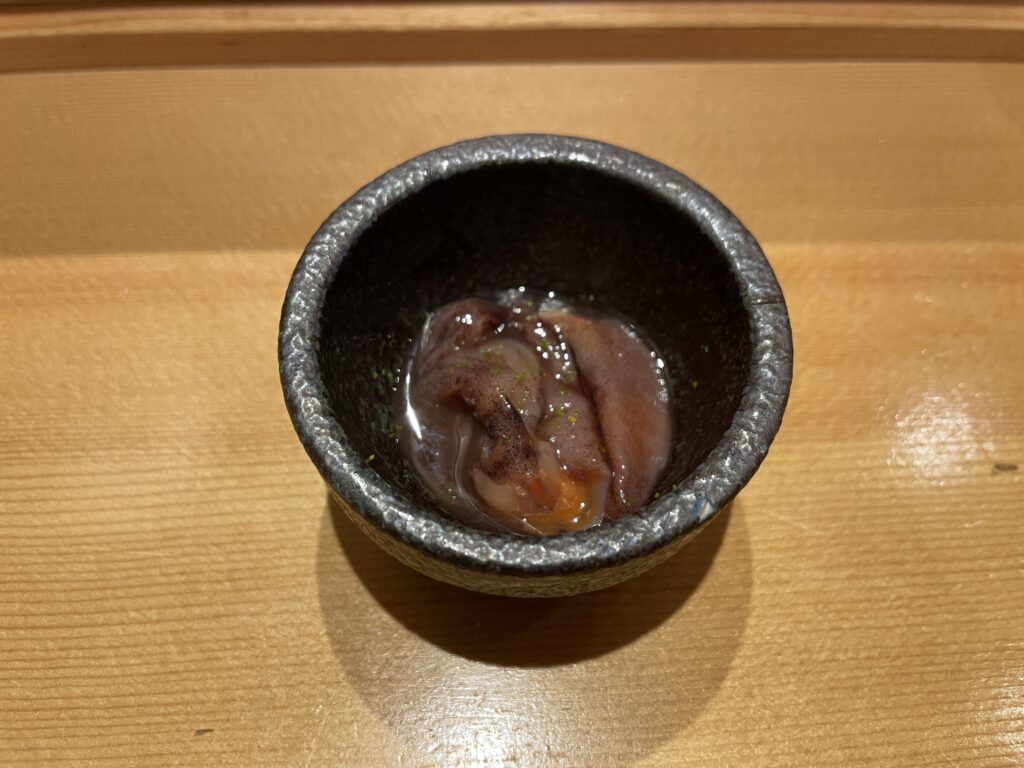 Salted squid
Salted squidTypes of Sushi Toppings
Next, let’s introduce some typical Sushi toppings:
“Maguro” – Tuna
Tuna needs no introduction as a sushi topping. It is particularly beloved in Japan. Tuna can be categorized into different cuts, including Akami (lean), Chu-toro (medium-fatty), and Otoro (fatty), with Otoro being a rare and premium choice due to its richness.
 Chu-Toro
Chu-Toro“Shiro mi” – Whitefish
The term “whitefish” refers to fish with white flesh, quite literally. Common examples include sea bream, flounder, and sea bass. These fish typically have a light and refreshing flavor.
“Hikari-mono” – Blue-Backed Fish
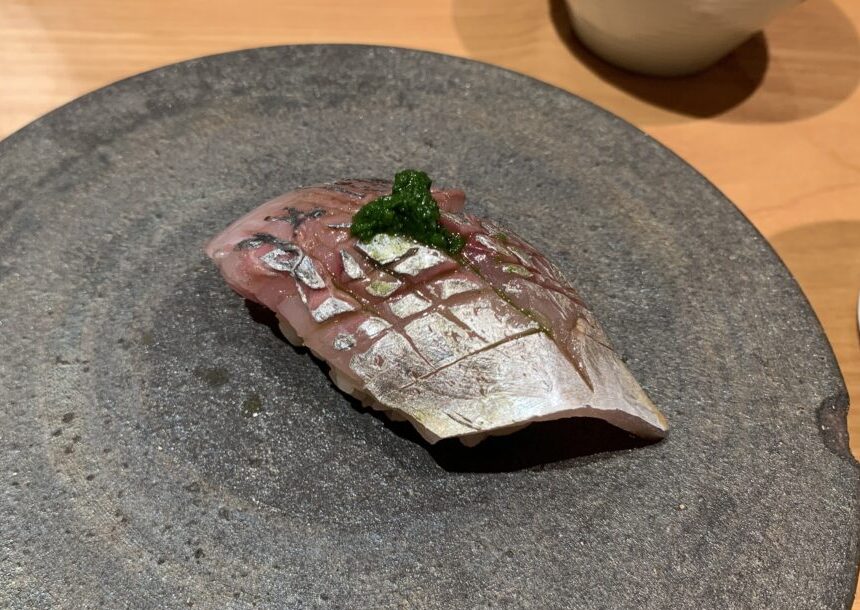 Aji – Nigiri
Aji – Nigiri“Blue-Backed Fish” refers to fish with a blue back and a white belly that appears to shine. Specific examples include horse mackerel, mackerel, sardine, and saury. These fish are sometimes marinated in vinegar due to their delicate texture and strong flavors.
“Kai” – Shellfish
 “Hotate” – Scallop
“Hotate” – ScallopShellfish also play a significant role in Sushi. Scallops, ark shells, oysters, and abalone are examples of shellfish used, each offering different textures and flavors.
 “Awabi” – abalone
“Awabi” – abalone“Ebi” – Shrimp
Shrimp, including tiger shrimp and sweet shrimp, are popular choices for Sushi. Tiger shrimp is renowned as a high-quality ingredient.
“Ika” and “Tako” – Squid and Octopus
Squid and octopus have unique textures and are important ingredients in Sushi. They can be enjoyed either raw or prepared through grilling or simmering.
Fish Roe
 “Ikura” – Salmon roe
“Ikura” – Salmon roeIn Japan, fish roe is a commonly consumed Sushi topping. Ikura (salmon roe) and Kazunoko (herring roe) are notable examples. Each type of roe has its own distinct texture.
“Uni” – Sea Urchin
 Uni Temaki
Uni TemakiUni, or Sea Urchin, is another important ingredient that shouldn’t be forgotten. Uni is famous as a representative Sushi ingredient, but interestingly, there are many Japanese people who aren’t fans of Uni. However, it’s a common story that even those who don’t initially like it often become fans when they try high-quality Uni.
Sushi Restaurant Etiquette, Taboos, and Tips
Here’s some information you should be aware of before visiting a Sushi restaurant, especially high-end Sushi Restaurants.
You don’t need to worry about these rules when going to Conveyor Belt Sushi restaurants.
Do Not Wear Perfume
This applies not only to Sushi restaurants but also to other dining places. When people around you wear strong perfumes or heavily scented cosmetics, it can hinder your ability to fully enjoy the aroma of the food. Please be considerate and refrain from wearing fragrances.
Use Soy Sauce on the Toppings, Not on the Rice
When eating Nigiri, the Sushi pieces are served with the topping placed on top of the rice. If the chef hasn’t already added soy sauce for you, when you dip the Nigiri in soy sauce, dip the topping side rather than the rice side. This prevents the rice from falling apart and avoids making a mess in your soy sauce dish.
Eat Nigiri and Sashimi in One Bite
For Nigiri and Sashimi, it’s customary to eat them in one bite. Cutting them in half can cause the rice to crumble, especially with Nigiri.
It’s Okay to Eat Nigiri with Your Hands or Chopsticks
Good news for those who aren’t comfortable with chopsticks: you can eat Nigiri with either your hand or chopsticks. On the other hand, for other dishes besides Nigiri and Sashimi, using chopsticks is more natural, but if you find them challenging, don’t hesitate to ask for a fork and/or spoon. It’s not considered impolite.
Don’t Disassemble Nigiri
Although you might be curious about what’s underneath the topping of your Nigiri, it’s considered impolite to disassemble it. Trust the chef’s preparation and enjoy it as it’s served.
Nigiri Sushi is Best Right Away
Sushi chefs take great care in creating the perfect balance of rice and air inside Nigiri. By warming the topping slightly with their hands, they enhance the taste. As time passes, the air inside the rice escapes, and the Sushi loses its ideal texture and flavor. While it’s understandable that you might want to chat or take photos, try to enjoy your Nigiri as soon as it’s served for the best experience.
Be Mindful of Watches and Accessories
In upscale Sushi restaurants, even the wood used for the counter is carefully chosen and carefully maintained. Polishing is done meticulously to achieve a unique soft texture. As a customer, you can show respect for their craftsmanship by removing metal objects from your hands to avoid accidentally scratching or damaging the counter, which the restaurant staff will appreciate. It’s advisable not to wear watches or bracelets that might come into contact with the counter, and it’s fine to put them in your bag or set them aside during your meal. Wearing rings is generally not a problem.
The Delicious Secrets of Japanese Sushi Restaurants
Especially in high-end Sushi restaurants, let’s explain why you can savor such delicious seafood dishes and the reasons behind it:
Surrounded by the Sea
Japan, being an island nation surrounded by the sea, has easy access to fresh ingredients. Seafood has been a staple in Japanese cuisine for a long time, and the food culture has evolved over the years.
Serving Seasonal Ingredients
Different fish spawn and migrate at various times, making them seasonal. Sushi chefs choose and serve the best seasonal ingredients, ensuring that whenever you visit, you’ll enjoy delicious dishes. Visiting at different times of the year allows you to experience a variety of ingredients.
Knowing How to Enjoy Ingredients
The ideal way to enjoy each ingredient can vary. For instance, some fish pairs well with Wasabi, while others are better with ginger or even a pinch of salt. Some are best when lightly cooked. Liver, surprisingly, can also be a delicacy. Sushi chefs are well-versed in bringing out the full potential of each ingredient, ensuring you enjoy it to the fullest.
Meticulous Preparations
Sushi restaurants go beyond slicing and serving fresh seafood. They engage in proper preparations to eliminate impurities and enhance flavors. For instance, fish may be briefly soaked in vinegar water, salted to remove excess moisture, or aged for days to weeks in controlled conditions to bring out their best flavors. It’s a misconception that fish is always best when extremely fresh. For example, the tuna you enjoy at high-end sushi restaurants in Japan has likely been aged for a few weeks. Some ingredients actually benefit from aging.
Blood Removal and Nerve Paralysis
The secret to the deliciousness of high-end Sushi restaurants also lies in what happens immediately after the fish is caught. Dedicated fishermen often go the extra mile by removing blood and paralyzing the nerves of the fish. This not only removes impurities but also keeps the flesh fresh for extended periods. Fish that has undergone this process can be aged to perfection, resulting in incredible flavors.
Knife Skills
Sushi chefs have specific philosophies on how to use their knives effectively. For example, using decorative cuts on Nigiri enhances their visual appeal. They also cut in a way that maintains the texture when you eat it. For squid, they make fine cuts to soften the texture, and for fatty cuts, they make strategic incisions to prevent soy sauce from sliding off.
Shari (Sushi Rice) and Wasabi
The rice, known as Shari, is also a canvas for the sushi chef’s skills. The vinegar and sugar ratios can vary by restaurant, and some places use different types of Shari for different toppings. By altering the Shari, chefs can enhance the potential of the Sushi ingredients.
Additionally, the quality and quantity of Wasabi are essential. For fatty cuts like Otoro, chefs may use more wasabi to balance the flavors. Otherwise, the Wasabi’s aroma might be overpowered by the fatty richness.
These are some of the secrets behind the deliciousness of Japanese Sushi restaurants. The combination of fresh ingredients, expert preparation, and an understanding of how to highlight each ingredient’s unique qualities results in an unparalleled dining experience.



